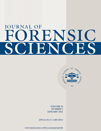Effect of Investigator Disturbance in Experimental Forensic Entomology: Carcass Biomass Loss and Temperature
Abstract
Abstract: Often carrion decomposition studies are conducted using a single carcass or a few carcasses sampled repeatedly through time to reveal trends in succession community composition. Measurements of biomass and other abiotic parameters (e.g., temperature) are often collected on the same carcasses but are rarely a focal point of the studies. This study investigated the effects that repeated sampling during experiments have on the decomposition of carrion, measured as both gross biomass (carcass plus fauna) and net biomass (carcass only), on carcasses disturbed on every visit (with weighing only or also with the collection of fauna) and on carcasses disturbed only once. Each trial lasted at least 21 days, with samples taken in triplicate. Rat carcasses used in this study were placed in the field on the same day and either weighed on every visit or ignored until a given day. Internal and ambient air temperatures were recorded on each carcass at the time of sampling and on undisturbed carcasses using temperature loggers. The presence of succession fauna did not result in significant biomass loss on most days; however, there were individual days early in decomposition (days 3 through 6) when the succession fauna comprised a large portion of the gross biomass. With the exception of biomass loss by the emigration of maggots on days 4 and 5, neither repeated weighing of the carcasses nor repeated weighing and faunal sampling of the carcasses statistically affected the rate of biomass loss. Internal temperatures of carcasses sampled repeatedly were frequently 2–5°C lower than those that had not been disturbed, and ambient temperatures differed significantly depending on the location of measurement device. Results indicate that methods used historically for biomass loss determination in experimental forensic entomology studies are adequate, but further refinements to experimental methodology are desirable.




